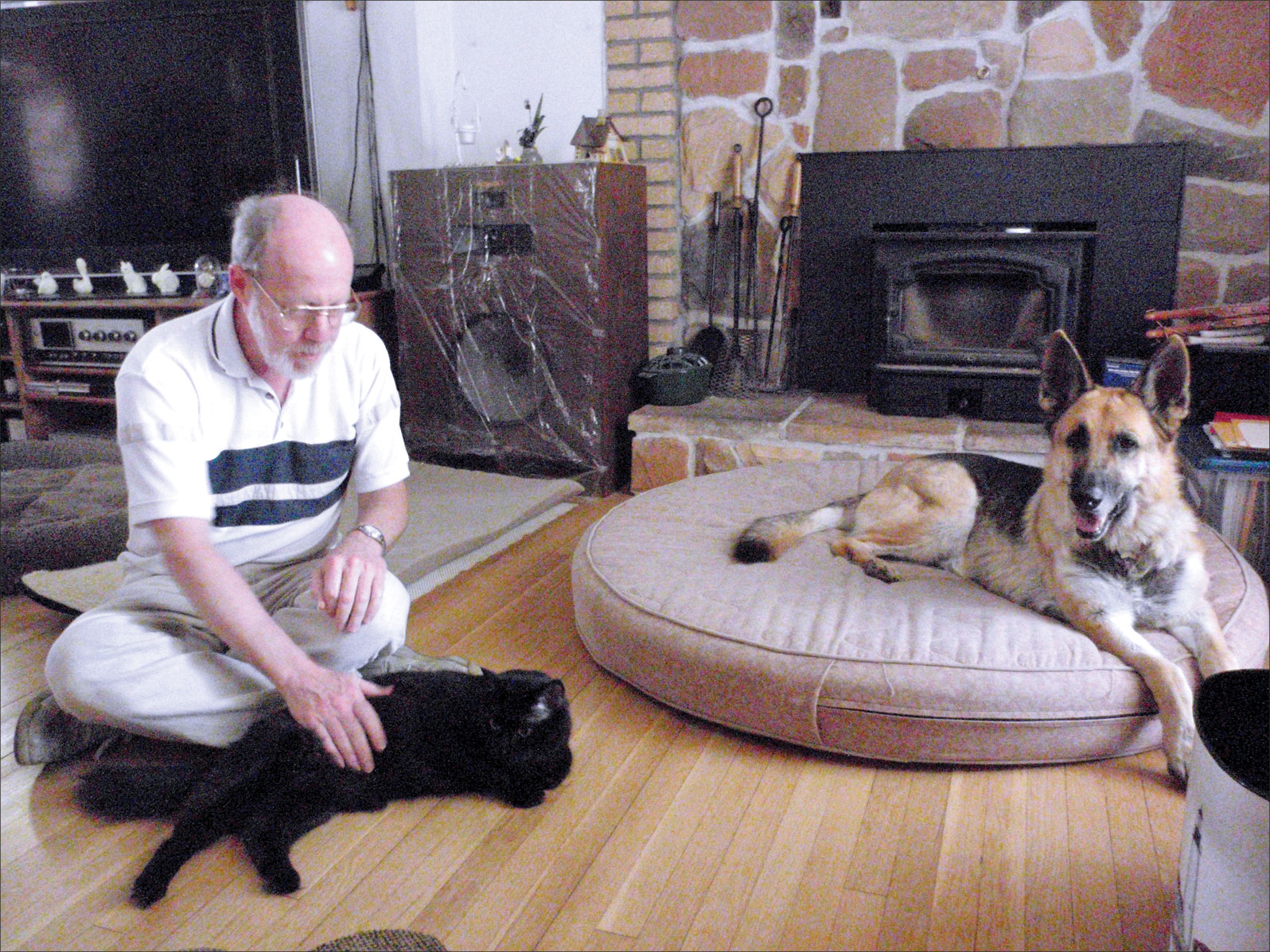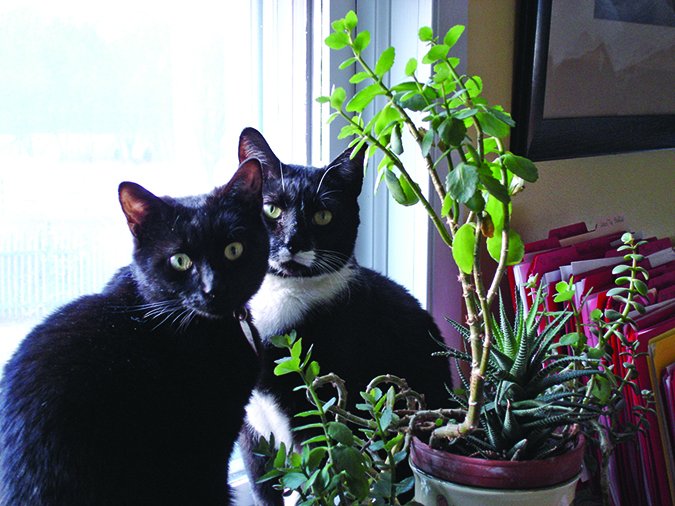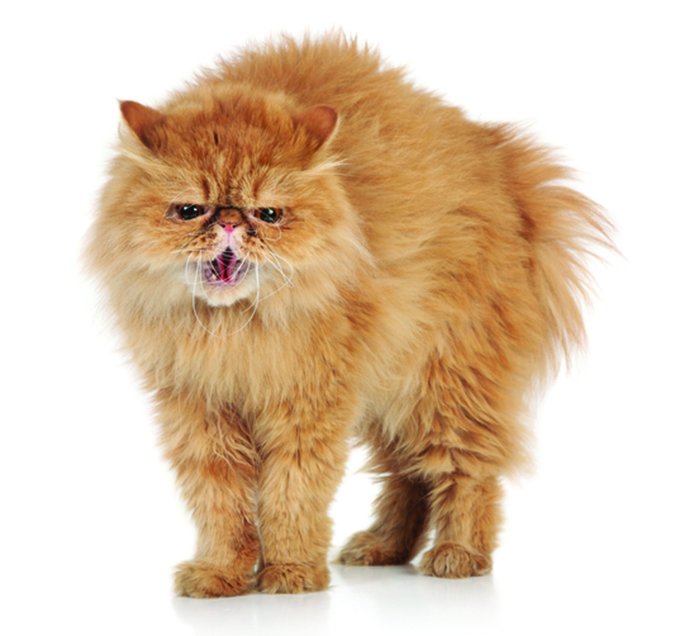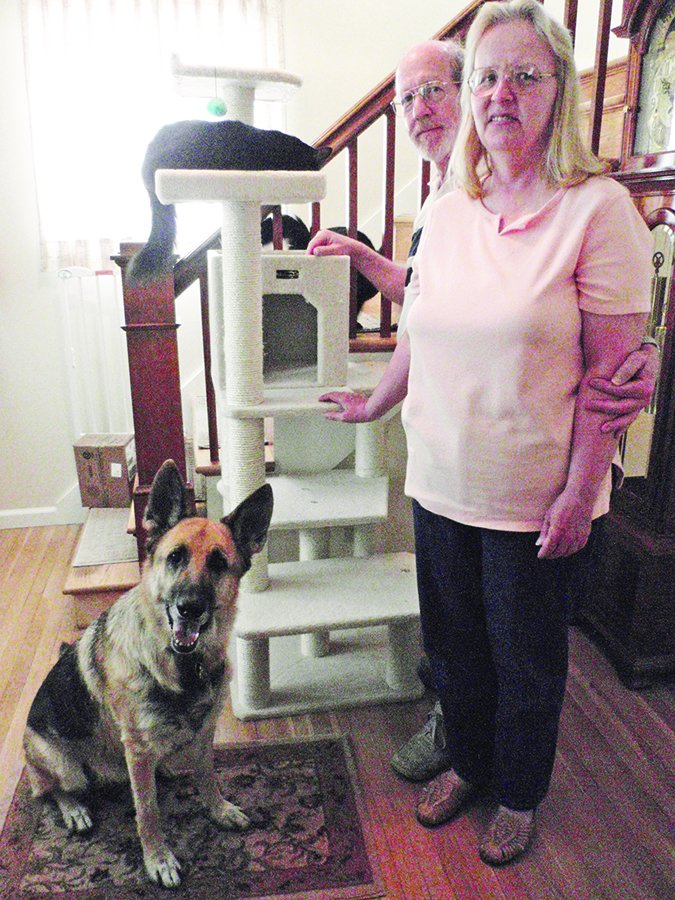[Updated October 19, 2017]
It’s fairly common for dogs to be placed for adoption with a caveat that there should be “no cats,” “no small animals,” or “no livestock” in their new homes. These warnings are usually based on observations of the dog while he spent time in a shelter or rescue, or on the dog’s history in his most recent home. While they are meant to prevent a tragedy, especially in the home of a well-meaning but not very experienced owner, the warnings can scare away committed owners who are willing and capable of addressing the dog’s predatory leanings. Here’s the story of one very determined couple who helped their new dog get past her cat-chasing past and go on to share her hearth with a pair of kitties.

Ken and Sue Johnson love German Shepherd Dogs and are very aware of the pet overpopulation problem. So it made sense, when their senior Shepherd died of old age, to adopt their next canine companion from a rescue group. They contacted a German Shepherd rescue, and adopted five-year-old black-and-tan Sara.
The rescue staff informed them that Sara, seized in a neglect case, had lived with cats in her previous home, so they felt confident taking her home to meet their senior cat. Much to their dismay, they discovered that while Sara may have lived with cats before, it probably wasn’t a harmonious relationship. When we met for our first behavior modification session they said, “We had a cat when we first brought Sara home. She chased the cat upstairs where he stayed for the next two months until he passed away.”
The Johnsons love cats, and were aching to adopt a bonded pair, to fill the void left by their last cat’s passing. Wisely, however, they didn’t want to subject two new cats to constant harassment by an aroused dog dedicated to terrorizing the felines. They asked if I could help Sara learn to get along with cats. I said we could try, and they signed up for a series of private behavior modification consults. The Johnsons were committed to keeping Sara whether we succeeded or not. They really wanted cats in their home, but were prepared to remain catless if we couldn’t make it work.
Finding a Good Feline Participant
We have three cats in the Miller household. Although they live with our own four dogs, I knew that Blue and Viva wouldn’t take kindly to participating in behavior modification sessions with a rowdy German Shepherd. Barney, however, is unflappable, and thus was drafted to be our “neutral cat.”
On the day of the Johnson’s first scheduled session in mid-December of 2012, I brought Barney out to the training center and placed him in a covered exercise pen, with a blanket over the top so he couldn’t leap out. We wanted him confined for his own safety, as well as to minimize his movement to help keep Sara’s arousal level low. I put an open carrier inside so Barney had a place to hide if he felt threatened by Sara. The stage was set and we waited for the Johnsons to arrive.
Cross-Species Relationships
While canines and felines are notorious for “fighting like cats and dogs,” they are not the only potential “mixed-family” challenge. Dogs who are not well socialized to other species can pose a threat to many other companion animals, from small rodents to rabbits, fish, birds, ferrets, pigs, goats, sheep, horses, and everything in between.
My modification protocol of choice for introducing a dog to a new species is classical conditioning: giving the dog a positive association with the new creature, while at the same time managing (with a leash, crate, baby gate, closed door, etc.) so said dog never learns the joy of chasing said (insert your species of choice here) in your home. Because classical and operant conditioning work together, at the same time your dog is creating a healthy association with your new furred, finned, or feathered family member (Cockatiels make pieces of delicious chicken appear!) he is also learning a new behavior (If I sit by my human’s side when the cockatiel is present I can make her feed me pieces of chicken!).
If you’re proactive with your introductions – and if your dog didn’t come to you with a lot of practice at chasing other animals – you can often create harmony in your household in a short time with reasonable effort.
If, however, you have a dog like Sara who already has an unhealthy predator/prey or other predatory association with other species, you’ll have to work hard to counter-condition (change) and desensitize her association and related behavior. Counter-conditioning is a “subset” of classical conditioning.
Classical conditioning is my preferred choice for many protocols because it is relatively easy to do well – easier for most of my clients, in my experience, than other options such as BAT and CAT (see “Other Modification Protocol Options,” below), and because I have had great success using it in a wide variety of behavior modification programs. I’ve seen it work well for everything from nail trimming and touch sensitivity, fear of cars and dog reactivity, resource guarding and fear-related aggression, to my own Scottish Terrier’s desire to maul Viva, the eight-week-old kitten we brought into our home 11 years ago.
Counter-Conditioning for Cat Tolerance – SESSION 1
The Johnsons arrived for their scheduled appointment, and after a brief discussion about the plan, we set to work. We initially introduced Sara to Barney-in-the-pen at a distance of 40 feet. I find that to be a good average threshold distance for most of my clients’ dogs in the presence of their arousal-causing stimuli. Not Sara! When she saw a cat 40 feet away she went immediately “over threshold” – ignoring food (venison instead of chicken, due to Sara’s food allergies), whining and aroused, trying to drag Susan toward the pen.
We backed up to 60 feet and tried again. At this increased distance Sara was able to begin working, and quickly made the association between the sight of Barney and receiving venison treats. Before long, she would look at Barney and quickly look back to Ken for her treat. This swift development of a conditioned emotional response (CER) gave us hope for success, despite her initial intense reaction to the sight of the cat in the pen. By the end of the session, Sara was able to be within 25 feet of Barney’s pen, with a relaxed, soft body language and expression.
Since the Johnsons didn’t have access to an accommodating Barney-style cat at home, I sent them off for two weeks to practice counter-conditioning Sara using the squirrels in her neighborhood – another source of high arousal for the dog.
SESSION 2
Improvement at the next session was slow but obvious. We started this session at a distance of 50 feet and ended 20 feet away from Barney in his pen. In fact, for the most part, Sara was far more interested in Ken and her venison than she was in Barney. We incorporated Leslie McDevitt’s “Look At That” (LAT) exercise so we could operantly cue Sara to look at Barney in order to get treats and continue strengthening the association between see-cat-and-receive-venison.

We added in “relax” sessions, moving 60 feet away from Barney and asking Sara to lie quietly at Ken and Susan’s feet. We continued to feed venison if she looked at Barney, but also reinforced her just for settling and relaxing. We wanted her to understand she could just “hang” in the vicinity of a cat without always expecting action. Susan reported that Sara was becoming much less aroused when she saw squirrels on their walks. I suggested the Johnson’s purchase a realistic-looking stuffed cat so they could practice CC&D with Sara in their home, in addition to their work with squirrels.
Sara had also been diagnosed with hypothyroidism and was on medication for this condition. The adjustment to her thyroid levels was doubtless contributing to her behavioral improvement.
SESSIONS 3-5
In the third session, we were able to consistently close the distance to 25 feet, getting good CERs, using the LAT cue to get Sara to look at Barney when needed, and interspersing “relax” periods in between the CC&D work. This session we taught Sara an operant “Find it!” exercise, so we would have a tool to refocus her if she appeared close to threshold.
Sara continued to show marked improvement in the next two sessions. We closed the distance to two feet, with Ken sitting on the floor between the dog and cat and petting them both. As proof that Sara was becoming non-threatening, Barney moved freely around his pen and even reached through the wires toward Ken. This sparked a little interest from Sara, but didn’t send her over threshold.
As he was sitting on the floor between Sara and Barney, Ken looked at me and said quietly, “I never thought we would be able to do this.” His heartfelt comment brought tears to my eyes.
Time for a serious discussion about where to proceed from here. I had begun reaching out to all my trainer contacts, looking for a bonded pair of cats in need of a home, and who grew up with dogs so they wouldn’t be put off by a dog who might become over-excited by their presence. We scheduled our next session at the Johnson home; Barney would be going on a field trip so Sara could practice her newly found calm skills in the presence of a cat in her own home.
SESSIONS 6-10
We did five sessions with Barney at the Johnsons’ home. Sara was, indeed, aroused at the first introduction to a cat in her own home. The Johnsons’ house is significantly smaller than our training center, and we had only about 20 feet maximum distance to put between the cat and dog where they could both still see each other. We set up Barney’s pen near the front door, by the stairs, and brought Sara in from the backyard.

Sara heard Barney meow before she saw him, and was instantly excited, whining and pulling toward the sound. Ken fed her until she calmed, and we moved her into view of Barney. With continued CC&D it took about 20 minutes for her to settle on her bed. We started implementing the Karen Overall Protocol for Relaxation – a procedure that teaches a dog to remain calm while the owner very gradually moves away from the dog. We didn’t want Sara to have to be right next to Ken and Susan the entire time cats were in the house. We also practiced “relax,” encouraging Sara to lie calmly on her side with her head down.
Session 10 was in mid-April, four months after we started working with Sara. She was now able to remain quite calm with Barney moving around freely in the pen. At this session we again had Ken sitting on the floor between dog and cat, and decided to risk going one step further and allow Sara to sniff Barney.
Sara greeted Barney calmly and politely, but to our surprise and dismay, Barney reacted with a loud hiss, and swatted Sara on the nose. Happily, Sara took the reprimand calmly, without any sign of arousal. She had just graduated from get-along-with-cat-school – with honors. Ken, Susan, and I looked at each other, delighted and amazed. “She’s as ready as she’ll ever be,” I said. Ken nodded.
I had located a trainer with a pair of cats who sounded like they met our needs perfectly. “I’ll call her,” Ken said.
Introducing the Household Cats
Ken and Susan met with my acquaintence and the two long-haired black cat brothers, Ralphie and Randy, and brought the cats home. We had agreed that the cats would stay safely stashed in a bedroom until our next session, when I could help with the introduction.
A week later I arrived for the big moment. Ken and Susan had been letting the cats roam the house whenever Sara was in the back yard, so she was familiar with their scent, and the cats made plenty of noise as they romped together in their bedroom, so she had heard them playing. We placed Ralph and Randy in the exercise pen that the Johnsons had purchased, and we brought Sara in.
Sara was curious but calm, and began offering CERs in less than three minutes. She easily went and laid down on her bed on cue, and didn’t become aroused when Ralph and Randy started to wrestle on their cat tree. After a thirty-minute session of CERs and relaxation, we invited Randy and Ralph back upstairs to their bedroom and breathed a collective sigh of relief. All was going according to plan.
I had one prepaid session left with the Johnsons. The plan was for them to continue controlled interaction daily between Sara and the cats for a couple of weeks – more concentrated now that they had their own cooperative cats to work with. However, changes in my schedule interfered, and it was a full month before I could come back for our final session at the end of May. I called the day before to confirm our appointment.
“How are things going?” I asked Susan when she answered the phone.
“We have an integrated household!” she exclaimed happily.
Although the plan had been to not allow free interaction until I was there to assist, Ralphie, the bolder of the cat brothers, had other plans. Several days before my scheduled visit he made a break for the bedroom door when Susan went in to feed him, and dashed down the stairs to the living room where Sara was resting. It was a non-event. All the Johnson’s hard work had paid off in spades. When I arrived for our final session all we had to do was sit and smile as we watched Sara, Ralphie, and Randy amicably sharing their living space.
Dogs and Other Species
The same CC&D technique that worked for Sara, Ralphie, and Randy can work equally well for conditioning your dog to get along with other species. A lot of our clients’ dogs are startled to meet horses for the first time they come to our property, and react to these monster-sized (to them) aliens by barking or even lunging at them. After a few “horses-make-chicken-happen” associations, most dogs behave appropriately around the horses, seeing them as a source of chicken rather than as threat or prey. I’ve even successfully counter conditioned a dog who had an unhealthy intensity about fish in an aquarium to live peacefully with his aquatic family members.

The Johnsons were successful in integrating cats into their home with the previously cat-reactive Sara for several reasons. Attention to these same factors will increase your likelihood of success regardless of what other species you might want to introduce into your household:
Short-Term Management – The Johnsons managed Sara’s environment so she wasn’t regularly reinforced for chasing cats or other small animals. Behaviors that are reinforced repeat and increase. It is well-nigh impossible to modify an unwanted behavior if the dog is allowed to repeatedly practice the behavior and be reinforced for it.
Whether fish, feline, fowl, ferret, or other small companion animal, keeping your new family members safely isolated from your dog when not under your direct supervision is key to success – unless and until you are 100 percent sure your dog will do them no harm. With large animals such as livestock, management for safety goes both ways. Just as your dog can injure or even kill a horse or cow, he can also be badly injured or killed by them. Manage, manage, manage, until you are confident that things will go well.
Long-Term Management – It’s too soon to know if Sara will ever be able to be trusted home alone with Ralphie and Randy. The signs are promising, and as long as all continues to go well, the Johnsons may soon start a program of gradual departures – for just a couple of minutes at first, and then adding a few minutes at time. If Sara at any time shows any indication of a return to her prior aroused behavior around the cats, then management will be long term, with dog and cats never left alone together when their humans aren’t home to intervene if needed. You will need to make the same judgment for your own multi-species household.
Commitment – The Johnsons were serious about their goal of adopting cats into their family, and were willing to commit their time, energy, and other resources into making it happen. I have many clients who are seriously committed to implementing the modification protocols we create, and I was still impressed by the Johnsons’ investment in helping Sara learn to accept cats in her home. It may not take as much time and energy if your dog is less intense about other animals than Sara, but you still need to be prepared to do what it takes to make it work.
Realistic Expectations – The Johnsons knew they would need to find behaviorally compatible cats. They were willing to wait until they could find the right cats, and until Sara was ready for cats to come into the home. Cats who were likely to be stressed by an intense dog would not have been a wise choice, nor would it have been smart (or fair) to rush things and introduce cats too soon in the process. Ken and Susan knew they were taking on a major project, and were prepared to give up their dream of adopting cats if we weren’t successful in our behavior modification program.
Prior History – The Johnsons were flying a little blind on this one. Although Sara reportedly had lived in harmony with cats in a prior home, her behavior didn’t support that statement. In fact, it appeared more likely that she hadn’t. Predatory behavior alone isn’t an automatic deal-breaker; the Miller dogs have killed groundhogs here on our farm, and still live quite peaceably with our three house cats.
However, if your dog has a strong reinforcement history for extremely inappropriate behavior toward other species – if he has successfully killed cats, or other domestic animals, it may be a huge challenge to bring potential prey into your home – and perhaps unfair to the potential victims. Think long and hard about how well you can manage your environment, and how committed you are to doing the work to modify the behavior. One management slip could be fatal.
Good News
The good news is that many dogs can and do live peacefully with other species. It happens day in and day out, all over the world. With a little luck your dog has no prior unhealthy association with the “other” of your choice, and you can plan to do a minimal classical conditioning program to get your housemates off together on the right paw, wing, or fin. If you end up with a dog like Sara, you may need to find a good, positive reinforcement-based behavior professional to help you. There’s a good chance you can make things work. Choose carefully, manage well, make the commitment, and be realistic.
Here’s to your happily blended multi-species household!
Pat Miller, CBCC-KA, CPDT-KA, is WDJ’s Training Editor. She lives in Fairplay, Maryland, site of her Peaceable Paws training center, where she offers dog training classes and courses for trainers. Pat is also author of many books on positive training, including, Do Over Dogs: Give Your Dog a Second Chance at a First-Class Life.






This is just the article I needed to read. I have a foster dog that is very focused on the cats. I will definitely follow these steps to work with him on being less reactive, aroused and more accepting. Thanks so much for this.